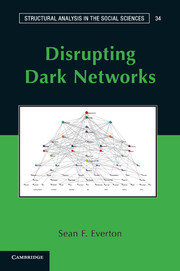Book contents
- Frontmatter
- Contents
- Figures
- Tables
- Preface
- Acknowledgments
- Part I Introduction
- Part II Social Network Analysis: Techniques
- Part III Social Network Analysis: Metrics
- Part IV Social Network Analysis: Advances
- Part V Conclusion
- 12 The Promise and Limits of Social Network Analysis
- Appendix 1 The Noordin Top Terrorist Network
- Appendix 2 Glossary of Terms
- Appendix 3 Multidimensional Scaling with UCINET
- Appendix 4 The Just War Tradition
- References
- Index
12 - The Promise and Limits of Social Network Analysis
Published online by Cambridge University Press: 05 April 2013
- Frontmatter
- Contents
- Figures
- Tables
- Preface
- Acknowledgments
- Part I Introduction
- Part II Social Network Analysis: Techniques
- Part III Social Network Analysis: Metrics
- Part IV Social Network Analysis: Advances
- Part V Conclusion
- 12 The Promise and Limits of Social Network Analysis
- Appendix 1 The Noordin Top Terrorist Network
- Appendix 2 Glossary of Terms
- Appendix 3 Multidimensional Scaling with UCINET
- Appendix 4 The Just War Tradition
- References
- Index
Summary
Introduction
We have come a very long way in a relatively short time. Chapter 1 introduced social network analysis's (SNA) basic terms, concepts, and assumptions of social network theories and methods, and Chapter 2 offered a strategic framework into which social network analysis can be embedded for the disruption of dark networks. Chapters 3 and 4 introduced UCINET, NetDraw, Pajek, and ORA and covered the basic skills needed for the collection, manipulation, and visualization of social network data. Chapters 5 through 11 examined some of the more common social network metrics for measuring network topography, detecting cohesive subgroups, finding central and peripheral actors, pinpointing brokers and bridges, locating structurally equivalent actors, analyzing longitudinal and geospatial network data, and disentangling genuine effects from spurious effects.
This final chapter considers the promises and limitations of social network analysis. SNA is not a silver bullet in the fight against terrorist and criminal networks but rather one tool that can be used in conjunction with other tools in the crafting of potential strategies. Moreover, there is also the concern that the theories and methods outlined in this book will be used for ill rather than good. This concern is not limited to SNA but is one that arises whenever knowledge is disseminated in classrooms, through journals, by the creation of software, and so on. Nevertheless, general guidelines do exist as to how such knowledge should be used, which is why this chapter explores the ethics of using SNA for the disruption of dark networks. It considers a variety of ethical traditions before arguing that the just war tradition, which is rooted in the Aristotelian idea that ethics should be guided by the goal of encouraging those practices that allow human beings to flourish, provides helpful guidelines for the proper (and improper) use of social network analysis.
- Type
- Chapter
- Information
- Disrupting Dark Networks , pp. 365 - 384Publisher: Cambridge University PressPrint publication year: 2012

